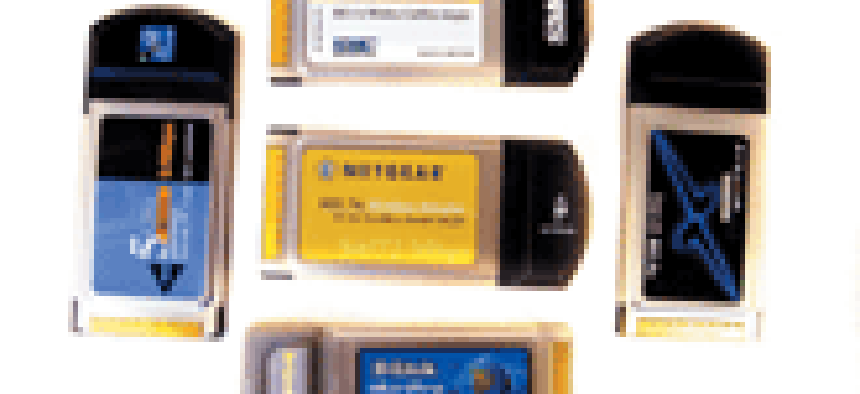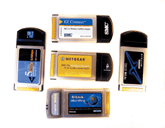The ideal office for a wireless network has a lot in common with an antenna. It's oval in shape and constructed of metal with lots of open space. It has no sharp corners, cubicles, plush chairs or chunky executives to reduce signal strength.Most wireless manufacturers report results from such environments. But in the real world, the conditions don't exist'well, except perhaps in some underground rooms at the Pentagon.The GCN Lab put IEEE 802.11a wireless networking products to the test in a real-world environment with carpets, acoustic tiles, corners and cubicles. Our test environment was a long corridor broken by cube dividers, chairs, a table and occasional passersby.We measured how long it took 100M of data to travel from a server to the wireless access point and then to a notebook PC Card. From ground zero beside the access point, we carried the notebook PC in 10-foot increments down the corridor until the signal was lost. We repeated this test many times at each incremental distance to get average scores for each product.Because 802.11a has a wider, 5-GHz band and transfers up to 54 Mbps compared with 802.11b's 2.4-GHz band and 11-Mbps maximum rate, we also tested 500M transfer at ground zero, right beside the access point to check raw power.Speed was the most important grading criterion, but we also factored in travel distances, prices of access points and PC Cards, ease of use and security.The 5-GHz bandwidth of 802.11a carries a signal a somewhat shorter distance than 802.11b. In our recent 802.11b review, we still got good signals an average of 88 feet from the access points, and it was not unusual to find usable signal strength at 120 feet.In contrast, the average cutoff distance for 802.11a products was 64 feet. Only the best access points in this review could push out to 80 feet.IEEE 802.11a access points and PC Cards are therefore suited best for small offices. Security is easier to manage than at 802.11b distances, but it's still important.Depending on your agency's needs and your existing network security infrastructure, you might want to consider access points that can hook up to a remote authentication dial-in server, or RADIUS. If your data requires multilayered security, you also should consider the ability to decline foreign service set identifiers'a capability known as SSID suppression.Without such suppression, rogue clients can attach to a wireless network without the administrator knowing.But in this review, the lab focused on distance and transfer rates as compared to price. The average transfer rates varied dramatically at different distances, sometimes independent of the distance between access point and PC client.For example, SMC Networks Inc.'s access point and card worked 20 seconds faster at 60 feet than at 40 feet. Such fluctuation is common with all WiFi technologies, but it was much more noticeable with 802.11a's greater bandwidth.Here's why: Say a car with a top speed of 11 miles per hour and a second car that covers up to 54 miles per hour both suddenly drop to half-speed. A passenger in the faster vehicle will notice the drop a lot more. So for grading purposes, we looked for both raw speed and a stable, reliable signal.NetGear Inc.'s NetGear HE102 wireless access point took our Reviewer's Choice designation for some of the fastest wireless transfer rates the lab has ever recorded, as well as having the farthest reach in this review'80 feet.The HE102 system was easy to set up and also the most affordable in the review, at $233 per access point and $40 per PC Card. It merited our Bang for the Buck designation and would be a great buy for an office where security is not the top concern.It couldn't join a RADIUS server, however, and it didn't suppress foreign SSIDs'part of the reason why it was so easy to set up and use.But NetGear's equipment was lightning-fast, beating all the rest for transferring 500M in an average 9 minutes, 21 seconds.In the 100M sprints, NetGear was among the most consistent performers, never losing signal dramatically but slowing down the farther our test notebook got from the access point.With products from other vendors such as SMC Networks and D-Link Systems Inc., we experienced dramatic six- to eight-minute time jumps while transferring the 100M file at the same distances.Like many of its competitors, the NetGear equipment could serve up to 64 simultaneous users and needed drivers to install the PC Cards under Microsoft Windows XP.What Proxim Corp.'s 802.11b Orinoco AP-2000 lacked in our Oct. 7 review, the 802.11a Proxim Harmony made up for this time, and then some. The earlier Orinoco came disassembled; the 802.11a Harmony was plug and play.It performed neck-and-neck with NetGear in speed testing. It was only 30 seconds slower on the 500M test and faster in the 100M test, up to 40 feet.Although the Harmony also merited a Reviewer's Choice designation, it lost signal 10 feet before the NetGear equipment did, and it cost twice as much: $510 for the access point and $166 per PC Card.Nevertheless, Proxim's Harmony did have some features that NetGear lacked. It could join a RADIUS server, and it had SSID suppression to keep out unauthorized users. If you need extra security as well as reliability, Harmony is the better choice.The D-Link DWL-6000AP access point had reliable connectivity, good transfer rates and quite a few extras. It was the only dual-band device in the review'accessible to clients with either 802.11a or 802.11b wireless cards. It cost at most $20 more than single-band 802.11a access points, and less than some. But equipping several users with the dual-band, $139 D-Link cards probably would not be cost-effective.The DWL-6000AP signal could reach out to 60 feet. Unlike most other equipment in the review, it showed no wild fluctuations between 10-foot increments. But link quality did begin to degrade a short distance from the access point. Although the 100M test took two minutes, 50 seconds at 20 feet, it lengthened to five minutes, 15 seconds between 20 and 40 feet. Between 40 and 60 feet, it took six minutes, 14 seconds.An administrator could fairly easily estimate each user's signal quality based on proximity to the D-Link access point. Someone in a cubicle 15 feet away should get a great signal, but large files would transfer slowly.The SMC 2755W performed well at a reasonable price. Testing did not start out smoothly, however. We tried to install the SMC card just after the D-Link test, and Microsoft Windows XP on our test notebook stubbornly insisted the SMC card was identical to the D-Link card. It kept trying to use the same driver, so the SMC card would not work.Once we had completely removed the D-Link files, we had to reinstall the SMC card on the test notebook by way of the installation CD-ROM. We didn't subtract points for this because we could not determine if it was the fault of SMC, D-Link or Microsoft Corp.On the 500M transfer test, the SMC unit behaved essentially just like the D-Link, taking an average 10 minutes, 13 seconds. It also worked fast within 20 feet of the access point, moving a 100M file in just two minutes, 29 seconds.As distance increased, however, performance dropped off more rapidly than with any other device in the review. Average transfer time between 20 feet and 40 feet was eight minutes, 32 seconds. Between 40 and 60 feet, the average surprisingly got better: eight minutes, five seconds. When we looked at performance in 10-foot increments, it varied wildly, although every other factor remained the same.We had to repeat the tests more than 15 times at each distance to get a reliable average score.Although the SMC 2755W performed well overall, there was no way to predict a strong signal at a given distance. Moving closer to the access point didn't always help, whereas moving farther away sometimes did.The Linksys WAP54A from Linksys Group Inc. started off like a racehorse bursting from the gate, but it tired before the race was done. Average time for a 100M transfer was an incredibly fast one minute, 37 seconds. For the larger 500M file, the Linksys finished in a respectable nine minutes, 36 seconds.Unfortunately, we could not get any signal beyond 20 feet despite repeated attempts. We began a transfer at 25 feet but lost signal after about a minute.We also experienced problems getting the Linksys PC Card to work with XP, although the card worked fine in another notebook running Windows 2000.The WAP54A had some extra security features beyond standard encryption. It supported SSID suppression and media access control layer filtering. Although it could not join a RADIUS server, company officials said this feature will be available soon via a flash memory upgrade.The limited range of 802.11a makes it unsuitable for large offices without several access points. Likewise, the buying criteria differ from those for 802.11b products.With 802.11b, security features such as manual signal management, SSID control and RADIUS ability are very important. But 802.11a products have fewer security enhancements.Above all, consistent transfer rates count in everyday use. At 54 Mbps, a 500M file theoretically should transfer in one minute, 14 seconds at less than a foot from the access point. Our fastest recorded time was with the NetGear access point: nine minutes, 21 seconds. The slowest time was for D-Link: 10 minutes, 15 seconds.These measured rates fell far short of the theoretical 54-Mbps maximum. Nevertheless, 802.11a equipment still could transfer 100M an average of four minutes faster than any 802.11b product we've ever reviewed.Cisco Systems Inc. of San Jose, Calif., also was scheduled to participate in this review but did not meet the entry deadline.
IEEE 802.11a wireless access points and PC Cards carry more data than 802.11b products but over shorter distances. The longest distance for the products tested for this review was about 80 feet.
Olivier Douliery







